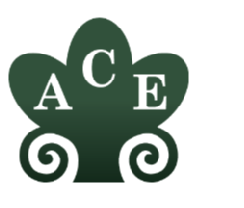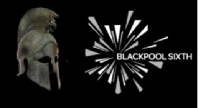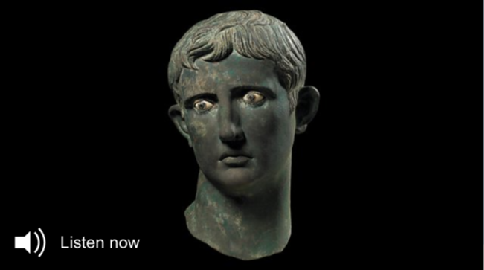Imperial Image (H408/22)
Prescribed Visual/ Material Sources
In these videos Dr Clare Rowan discusses coins in the age of Augustus, particularly focussing on the coins studied as part of the OCR Classical Civilisation A-level module 'Imperial Image'.
If you are after additional sources to diversify the curriculum, a powerpoint looking at Roman gems, tokens and provincial coinage is available for download here.
Dr. Clare Rowan on the Imperial Image and Tokens
There is specific discussion on tokens as evidence for the reception of the coinage showing Gaius and Lucius as Augustus' heirs. You are also free to make use of the powerpoint, this article in Omnibus, and the direct link to the exhibition on Roman tokens at the Hunterian Museum in Glasgow.
Dr. Clare Rowan on Thinking about Livia and the Imperial Image
The video discusses the basalt portrait of Livia, and thinks about why Livia's numismatic appearances under Augustus. You are also free to make use of the powerpoint; if you are interested in learning more about tokens this is the link to the online exhibition on Roman tokens at the Hunterian.
#AskAnAcademic: Dr. Clare Rowan on The Age of Augustus on Coins Part One: Divi Filius, Imperator, Augustus
#AskAnAcademic: Dr. Clare Rowan on The Age of Augustus on Coins Part Two: Culture Hero, Later Representations, Pater Patriae
Recorded at our 2019 Class Civ Teachers Day, Professor Alison Cooley here leads an engaging talk on 'Augustus in his own words - the Res Gestae Divi Augusti' discussing a topic for which her book is the A-level set text. A handout can be downloaded here, and you can access Prof Cooley's PowerPoint here.
And following this session, here Dr Clare Rowan speaks on 'The evidence of coins for Imperial Image' - a subject for which she also recently recorded one of our popular #AskAnAcademic videos (see above). Dr Rowan's Handout can be accessed here.
ACE Teaching Resources

Here at WCN we are proud of our association with ACE (Advocating Classics Education) and are pleased to be able to host their teaching resources here on the WCN site.
As part of their Classical Civilisation Teachers Summer School, held at King’s College London, ACE has prepared a series of introductory talks, delivered by leading academics and tailored specifically for the GCSE and AS/A-level Classical Civilisation syllabi.
The resources here are divided according to syllabus, but you can find the complete teacher resources from ACE and their Class Civ Teachers events via this link. You can find out more about the remarkable work of ACE on their dedicated website.
Prescribed Visual/Material Sources - Videos

 Peter Wright of Blackpool Sixth has created some videos in his inimitable style (check out the music) for the Imperial Image module.
Peter Wright of Blackpool Sixth has created some videos in his inimitable style (check out the music) for the Imperial Image module.
You can find out more about Ancient History at Blackpool Sixth through their Twitter, and check out Peter's own Twitter account and Youtube Channel for more content.
Podcast: The first emperor and the queen of inscriptions: Augustus in his own words
Prof Alison Cooley discusses Augustus’ account of his long reign.
During the last days of the Roman Republic, one man emerged victorious: Octavian, Caesar’s adoptive son, later called Augustus. After his ascent to power, he pacified large parts of the known world. In Rome, he kept the populace happy with bread and circuses, and slowly eliminated all opposition. Yet he also had to confront major set-backs. For instance, the scandalous infidelity of his daughter and granddaughter became the gossip of the empire.
Augustus built himself a massive mausoleum, and composed an account of his reign, which was placed onto pillars outside it after his death. It is the ‘queen of inscriptions’, and survives in three copies from Galatia, in central Turkey.
So who was this man who became the first emperor of Rome, and shaped history like few others? How did Augustus obtain and retain his colossal power for nearly half a century? And how does his account, recorded in the ‘queen of inscriptions’, differ from other historical sources?
Head of Augustus
[Source: BBC Radio 4 - A History of the World in 100 Objects, Empire Builders (300 BC - 1 AD)]
Neil MacGregor concludes the first week of the second part of his global history as told through objects from the British Museum. This week he has been exploring the lives and methods of powerful rulers around the world about 2000 years ago, from Alexander the Great in Egypt to Asoka in India. Today he introduces us to the great Roman emperor Augustus, whose powerful, God-like status is brilliantly enshrined in a larger than life bronze head with striking eyes.
Neil MacGregor describes how Augustus dramatically enlarged the Roman Empire, establishing his image as one of its most familiar objects. The historian Susan Walker and the politician Boris Johnson help explain the power and methodology of Augustus.
The Fall of Sejanus
Prof. Kevin Butcher of the University of Warwick on the fall of Sejanus during the reign of the emperor Tiberius.
Caligula and his Sisters
Prof. Kevin Butcher of the University of Warwick on a coin representing Caligula and his sisters.
Nero and Agrippina
Prof. Kevin Butcher of the University of Warwick on what can be learnt of the accession of Nero from the study of a coin showing the emperor with his mother, Agrippina.
Nero Plays the Lyre
Prof. Kevin Butcher of the University of Warwick on the image of the lyre player on a Neronian coin.
Hadrian: The Power of Image
[Source: The British Museum]
For many years Hadrian was perceived as a peace-loving admirer of Greek culture and customs, a philhellene. But the one statue on which this long-standing perception was based is not all that it should be. British Museum curator Thorsten Opper and conservator Tracey Sweek investigate.

